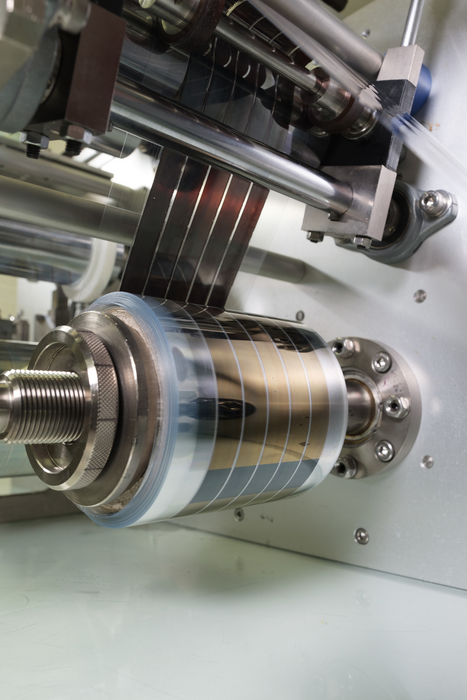Next-generation perovskite solar cells may be able to be printed at scale and take over the market for commercial photovoltaic with the aid of simple and customizable nanoparticle ink.
 An example of roll-to-roll printed solar cells being created. Image Credit: Commonwealth Scientific and Industrial Research Organization.
An example of roll-to-roll printed solar cells being created. Image Credit: Commonwealth Scientific and Industrial Research Organization.
The tin oxide-based ink is produced utilizing microwave technology in a single crucial step at a low temperature without the need for further purification. After that, it is employed in solar cells to aid in the selective movement of electrons, a critical phase in the production of energy.
Power-conversion efficiencies of 18% have been seen in prototype devices created using this technique, which is among the greatest efficiencies for a planar-structured perovskite solar cell treated at low temperatures.
The ink may be used to create many types of perovskite solar cells, including those with glass and for printing on plastic, both of which can be done at low cost and in large quantities. This process referred to as the roll-to-roll coating is comparable to how newspapers are printed.
The average size of each particle inside the ink product may be adjusted to stay between the range of 5 and 10 nm. To put it into perspective, consider that human fingernails grow one nanometer per second and that a sheet of paper is 100,000 nm thick.
Perovskite solar cells are more flexible and take less energy to manufacture than their well-established silicon equivalents, and they already challenge their efficiency.
These intriguing materials have not yet replaced silicon because of issues with long-term endurance and some production barriers.
However, with their tin oxide nanoparticle ink, scientists from the ARC Centre of Excellence in Exciton Science and Australia’s national science agency CSIRO may have discovered a solution to some of these problems.
The study’s findings, which were published in the journal Chemistry of Materials and are accessible online, were supported by the Australian Renewable Energy Agency (ARENA).
Perovskite solar cells can be manufactured by industrial printing. While the process is inherently low-cost, the cost of every component still counts. This work demonstrates a great way to contribute to ultra-low-cost manufacturing of perovskite solar cells in the future.
Dr. Doojin Vak, Principal Research Scientist, Commonwealth Scientific and Industrial Research Organization
As the direct high-temperature processing of adaptable solar cell substrates results in deterioration and reduces the economic potential of printed perovskite solar cells, it is crucial that the nanoparticle ink be produced using microwaves.
The use of microwaves to synthesize suitable nanoparticle inks provides a major step forward towards achieving high efficiency perovskite solar cells that can be reproducibly printed while also minimizing fabrication costs.
Jacek Jasieniak, Study Senior Author and Professor, ARC Centre of Excellence in Exciton Science, Department of Materials Science and Engineering, Faculty of Engineering, Monash University
Other synthetic methods for tin oxide need high pressure, high boiling temperatures, and sometimes many processing stages, disqualifying them from being produced at an affordable cost on an industrial and commercial scale.
The longevity of the final perovskite solar cell devices is further increased by using metal oxides rather than organic components, which are adversely affected by air and moisture.
Tin oxide is ideal for many kinds of solar cells and other optoelectronic applications because it has a broadband gap, is more robust than equivalent organic components, and promotes efficient electron transport.
Journal Reference:
Nirmal Peiris, T. A., et al. (2022) Non-Aqueous One-Pot SnO2 Nanoparticle Inks and Their Use in Printable Perovskite Solar Cells. Chemistry of Materials. doi.org/10.1021/acs.chemmater.2c00578.